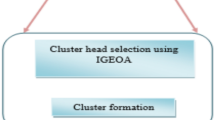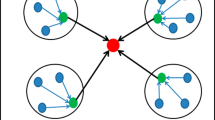Abstract
As Wireless Sensor Networks (WSNs) offer essential support for several location-aware applications and protocols, localization is one of the principal methodologies in WSN. In the literature, the mobile anchor node is preferred over the static anchor node to handle the high overhead issue caused by the larger number of anchor nodes. In recent years, the Mobile Anchor Node Assisted Localization (MANAL) problem has received significant attention in various research works, and path-planning techniques for localization using fewer anchor nodes have been implemented. However, recent MANAL breakthroughs in WSNs have provided ample research opportunities. The mobile anchor node is used in this paper to solve the node localization problem in WSN. The locations of the target nodes are determined using a Hybrid Electric-Coyote Optimization Algorithm (HE-COA), the mobile anchor node, and the virtual anchor nodes. The objective of the proposed localization is to minimize the distance error between actual node coordinates and estimated node coordinates. Various path trajectories are investigated in simulation to demonstrate the efficacy of the suggested work. The simulation results show that the proposed algorithm can reduce the localization error compared to the conventional models.












Similar content being viewed by others
Availability of data and material (data transparency)
Not applicable.
Code availability (software application or custom code)
Not applicable.
References
Ding Y, Wang C, **ao L (2010) Using mobile beacons to locate sensors in obstructed environments. J Parallel Distrib Comput 70(6):644–656
Koutsonikolas D, Das SM, Hu YC (2007) Path planning of mobile landmarks for localization in wireless sensor networks. Comput Commun 30(13):2577–2592
Pandey OJ, Gautam V, Jha S, Shukla MK, Hegde RM (2020) Time synchronized node localization using optimal H-node allocation in a small world WSN. IEEE Commun Lett 24(11):2579–2583
Pandey OJ, Mahajan A, Hegde RM (2018) Joint localization and data gathering over a small-world WSN with optimal data MULE allocation. IEEE Trans Veh Technol 67(7):6518–6532
Caceres Najarro LA, Song I, Kim K (2022) Fundamental limitations and state-of-the-art solutions for target node localization in WSNs: a review. IEEE Sens J 22(24):23661–23682
Cui H, Wang Y, Lv J (2012) Path planning of mobile anchor in three-dimensional wireless sensor networks for localization. J Inf Comput Sci 9(8):2203–2210
Ssu K, Ou C, Jiau HC (2005) Localization with mobile anchor points in wireless sensor networks. IEEE Trans Veh Technol 54(3):1187–1197
Lee S, Kim E, Kim C, Kim K (2009) Localization with a mobile beacon based on geometric constraints in wireless sensor networks. IEEE Trans Wirel Commun 8(12):5801–5805
Caceres Najarro LA, Song I, Tomic S, Kim K (2020) Fast localization with unknown transmit power and path-loss exponent in WSNs based on RSS measurements. IEEE Commun Lett 24(12):2756–2760
Yan X, Sun L, Sun Z, Zhou J, Song A (2018) Improved hop-based localisation algorithm for irregular networks. IET Commun 13:520527
Cui H, Wang Y (2012) Four-mobile-beacon assisted localization in three-dimensional wireless sensor networks. Comput Electr Eng 38(3):652–661
Ou C, He W (2013) Path planning algorithm for mobile anchor based localization in wireless sensor networks. IEEE Sens J 13(2):466–475
Amundson I, Koutsoukos XD (2009) A survey on localization for mobile wireless sensor networks. In: Mobile entity localization and tracking in GPS-less environnments, In: Lecture notes in computer science, vol 5801, pp 235–254
Akcan H, Kriakov V, Bronnimann H, Delis A (2010) Managing cohort movement of mobile sensors via GPS-free and compass free node localization. J Parallel Distrib Comput 70(7):743–757
Han G, Xu H, Jiang J, Shu L, Hara T, Nishio S (2013) Path planning using a mobile anchor node based on trilateration in wireless sensor networks. Wirel Commun Mob Comput 13(14):1324–1336
Kim E, Lee S, Kim C, Kim K (2010) Mobile beacon-based 3D-localization with multidimensional scaling in large sensor networks. IEEE Commun Lett 17(7):647–649
Huiya L, Jianbo X (2010) Path planning for mobile beacon nodes in localization for wireless sensor networks. Chin J Sens Actuators 23:873–877
Han G, Yang X, Liu L, Guizani M, Zhang W (2017) A disaster management-oriented path planning for mobile anchor node based localization in wireless sensor networks. IEEE Trans Emerg Top Comput 99:1–1
Han G, Chao J, Zhang C, Shu L, Li Q (2014) The impacts of mobility models on dv-hop based localization in mobile wireless sensor networks. J Netw Comput Appl 42:70–79
Rezazadeh J, Moradi M, Ismail AS, Dutkiewicz E (2014) Superior path planning mechanism for mobile beacon-assisted localization in wireless sensor networks. IEEE Sens J 14(9):3052–3064
Han G, Zhang C, Lloret J, Shu L, Rodrigues JJPC (2014) A mobile anchor assisted localization algorithm based on regular hexagon in wireless sensor networks. Sci World J. https://doi.org/10.1155/2014/219371
Erdemira E, Engin Tuncer T (2018) Path planning for mobile-anchor based wireless sensor network localization: static and dynamic schemes. Ad Hoc Netw. https://doi.org/10.1016/j.adhoc.2018.04.005
Halder S, Ghosal A (2016) A survey on mobile anchor assisted localization techniques in wireless sensor networks. Wirel Netw 22:2317–2336. https://doi.org/10.1007/s11276-015-1101-2
Song L, Zhu JR, Zhang P (2017) Node localization algorithm based on mobile anchor in wireless sensor networks. December
Tingting XU, **g**g WANG, Wei SHI, Jianfeng WANG, Zhe CHEN (2019) A localization algorithm using a mobile anchor node based on region determination in underwater wireless sensor networks. J Ocean Univ China (Oceanic and Coastal Sea Research) 18(2):394–402
Singh P, Khosla A, Kumar A, Khosla M (2017) 3D localization of moving target nodes using single anchor node in anisotropic wireless sensor networks. AEU Int J Electron C 82:543–552
Sun S, Zhao J, Tian X, Zhang J (2019) Path planning for multiple mobile anchor nodes assisted localization in wireless sensor networks. Measurement 141:124–136
Singh P, Khosla A, Kumar A, Khosla M (2018) Optimized localization of target nodes using single mobile anchor node in wireless sensor network. AEU Int J Electron C 91:55–65
Kaushik A, Lobiyal D (2021) Localization in mobile wireless sensor networks using drones. Trans Emerg Telecommun Technol. https://doi.org/10.1002/ett.4213
Kaushik A, Lobiyal DK (2021). Localization in wireless sensor networks using a mobile anchor and subordinate nodes. In: Applied soft computing and communication networks. Lecture notes in networks and systems, vol 187, pp 177–188. Springer, Singapore
Han G, Jiang J, Zhang C, Duong TQ, Guizani M, Karagiannidis G (2015) A survey on mobile anchor node assisted localization in wireless sensor networks. IEEE Access
Han G, Jiang J, Zhang C, Duong TQ, Guizani M, Karagiannidis GK (2016) A survey on mobile anchor node assisted localization in wireless sensor networks. IEEE Commun Surv Tutor 18(3):2220–2243
Sagan H (1994) “Hilberts space-filling curve,’’ Space-filling curves. Springer, Berlin, pp 9–30
Joshi AA, Bhatt MC, Sinha A (2019) Modification of Hilbert’s space-filling curve to avoid obstacles: a robotic path-planning strategy. In: 2019 sixth Indian control conference (ICC), Hyderabad, India, pp 338–343
Bader M, Bungartz HJ, Mehl M (2011) Space-filling curves. In: Padua D (ed) Encyclopedia of parallel computing. Springer, Boston, MA. https://doi.org/10.1007/978-0-387-09766-4_145
Ren X, Gao C, ** Y (2013) A node localization algorithm based on simple particle swarm optimization in wireless sensor networks. J Comput Inf Syst 9(22):9203–9210
Raja S, Amudhavel J, Dhavachelvan P, Vengattaraman T (2017) GWO-LPWSN: Grey Wolf optimization algorithm for node localization problem in wireless sensor networks. J Comput Netw Commun 2017(2):1–10
Yuan Z, Wang W, Wang H, Yildizbasi A (2020) Developed Coyote Optimization Algorithm and its application to optimal parameters estimation of PEMFC model. Energy Rep 6:1106–1117
Yilmaz S, Sen S (2020) Electric fish optimization: a new heuristic algorithm inspired by electrolocation. Neural Comput Appl 32:11543–11578
Han G, Jiang J, Chao J, Yang X (2017) Path planning for a group of mobile anchor nodes based on regular triangles in wireless sensor networks. Neurocomputing 270(C):198208
Xue W, Qiu W, Hua X, Yu K (2017) Improved Wi-Fi RSSI measurement for indoor localization. IEEE Sens J 17(7):2224–2230
Pandey OJ, Hegde RM (2017) Node localization over small world WSNs using constrained average path length reduction. Ad Hoc Netw 67:87–102
Funding
Not applicable.
Author information
Authors and Affiliations
Corresponding author
Ethics declarations
Conflicts of interest
No conflict of interest.
Additional information
Publisher's Note
Springer Nature remains neutral with regard to jurisdictional claims in published maps and institutional affiliations.
Rights and permissions
Springer Nature or its licensor (e.g. a society or other partner) holds exclusive rights to this article under a publishing agreement with the author(s) or other rightsholder(s); author self-archiving of the accepted manuscript version of this article is solely governed by the terms of such publishing agreement and applicable law.
About this article
Cite this article
Sekhar Rao Rayavarapu, V.C., Mahapatro, A. & Kanti, R.D. Design and development of mobile anchor assisted node localization strategy using a Hybrid Electric-Coyote Optimization. Evol. Intel. 17, 1405–1423 (2024). https://doi.org/10.1007/s12065-023-00834-2
Received:
Revised:
Accepted:
Published:
Issue Date:
DOI: https://doi.org/10.1007/s12065-023-00834-2




